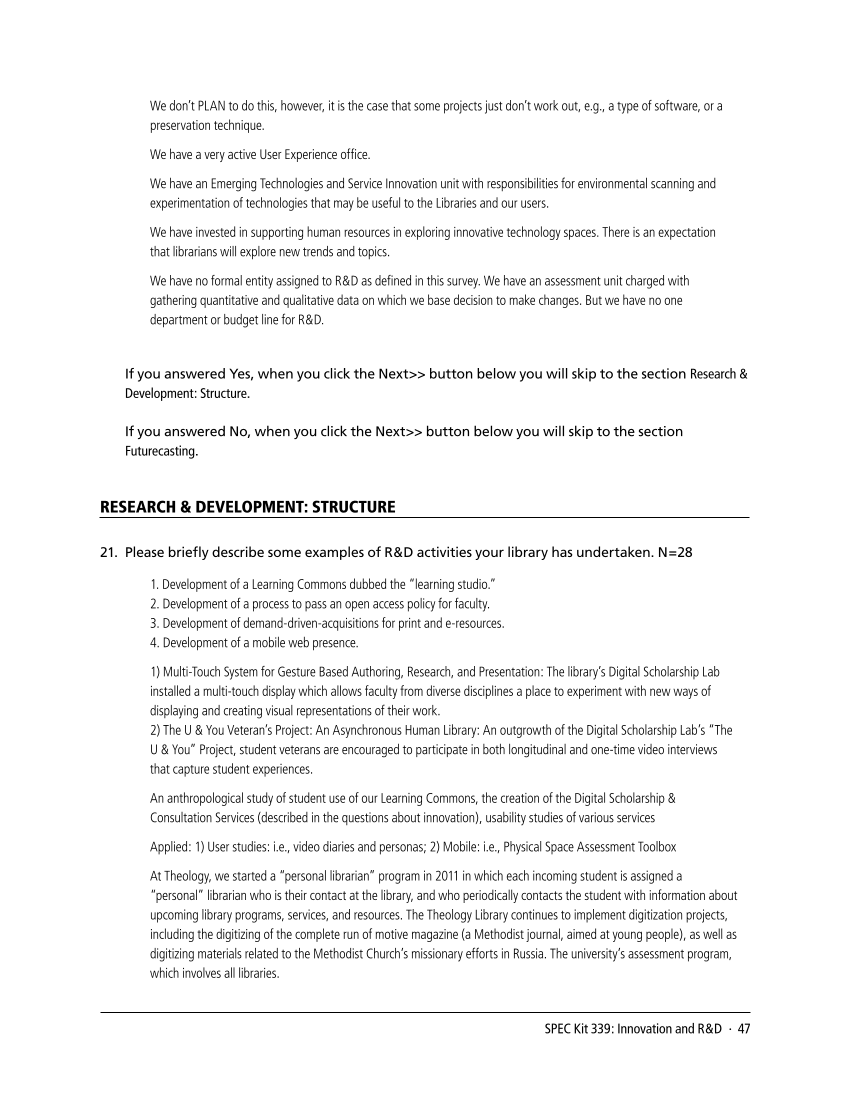SPEC Kit 339: Innovation and R&D · 47
We don’t PLAN to do this, however, it is the case that some projects just don’t work out, e.g., a type of software, or a
preservation technique.
We have a very active User Experience office.
We have an Emerging Technologies and Service Innovation unit with responsibilities for environmental scanning and
experimentation of technologies that may be useful to the Libraries and our users.
We have invested in supporting human resources in exploring innovative technology spaces. There is an expectation
that librarians will explore new trends and topics.
We have no formal entity assigned to R&D as defined in this survey. We have an assessment unit charged with
gathering quantitative and qualitative data on which we base decision to make changes. But we have no one
department or budget line for R&D.
If you answered Yes, when you click the Next button below you will skip to the section Research &
Development: Structure.
If you answered No, when you click the Next button below you will skip to the section
Futurecasting.
RESEARCH &DEVELOPMENT: STRUCTURE
21. Please briefly describe some examples of R&D activities your library has undertaken. N=28
1. Development of a Learning Commons dubbed the “learning studio.”
2. Development of a process to pass an open access policy for faculty.
3. Development of demand-driven-acquisitions for print and e-resources.
4. Development of a mobile web presence.
1) Multi-Touch System for Gesture Based Authoring, Research, and Presentation: The library’s Digital Scholarship Lab
installed a multi-touch display which allows faculty from diverse disciplines a place to experiment with new ways of
displaying and creating visual representations of their work.
2) The U &You Veteran’s Project: An Asynchronous Human Library: An outgrowth of the Digital Scholarship Lab’s “The
U &You” Project, student veterans are encouraged to participate in both longitudinal and one-time video interviews
that capture student experiences.
An anthropological study of student use of our Learning Commons, the creation of the Digital Scholarship &
Consultation Services (described in the questions about innovation), usability studies of various services
Applied: 1) User studies: i.e., video diaries and personas 2) Mobile: i.e., Physical Space Assessment Toolbox
At Theology, we started a “personal librarian” program in 2011 in which each incoming student is assigned a
“personal” librarian who is their contact at the library, and who periodically contacts the student with information about
upcoming library programs, services, and resources. The Theology Library continues to implement digitization projects,
including the digitizing of the complete run of motive magazine (a Methodist journal, aimed at young people), as well as
digitizing materials related to the Methodist Church’s missionary efforts in Russia. The university’s assessment program,
which involves all libraries.
We don’t PLAN to do this, however, it is the case that some projects just don’t work out, e.g., a type of software, or a
preservation technique.
We have a very active User Experience office.
We have an Emerging Technologies and Service Innovation unit with responsibilities for environmental scanning and
experimentation of technologies that may be useful to the Libraries and our users.
We have invested in supporting human resources in exploring innovative technology spaces. There is an expectation
that librarians will explore new trends and topics.
We have no formal entity assigned to R&D as defined in this survey. We have an assessment unit charged with
gathering quantitative and qualitative data on which we base decision to make changes. But we have no one
department or budget line for R&D.
If you answered Yes, when you click the Next button below you will skip to the section Research &
Development: Structure.
If you answered No, when you click the Next button below you will skip to the section
Futurecasting.
RESEARCH &DEVELOPMENT: STRUCTURE
21. Please briefly describe some examples of R&D activities your library has undertaken. N=28
1. Development of a Learning Commons dubbed the “learning studio.”
2. Development of a process to pass an open access policy for faculty.
3. Development of demand-driven-acquisitions for print and e-resources.
4. Development of a mobile web presence.
1) Multi-Touch System for Gesture Based Authoring, Research, and Presentation: The library’s Digital Scholarship Lab
installed a multi-touch display which allows faculty from diverse disciplines a place to experiment with new ways of
displaying and creating visual representations of their work.
2) The U &You Veteran’s Project: An Asynchronous Human Library: An outgrowth of the Digital Scholarship Lab’s “The
U &You” Project, student veterans are encouraged to participate in both longitudinal and one-time video interviews
that capture student experiences.
An anthropological study of student use of our Learning Commons, the creation of the Digital Scholarship &
Consultation Services (described in the questions about innovation), usability studies of various services
Applied: 1) User studies: i.e., video diaries and personas 2) Mobile: i.e., Physical Space Assessment Toolbox
At Theology, we started a “personal librarian” program in 2011 in which each incoming student is assigned a
“personal” librarian who is their contact at the library, and who periodically contacts the student with information about
upcoming library programs, services, and resources. The Theology Library continues to implement digitization projects,
including the digitizing of the complete run of motive magazine (a Methodist journal, aimed at young people), as well as
digitizing materials related to the Methodist Church’s missionary efforts in Russia. The university’s assessment program,
which involves all libraries.
































































































































































































